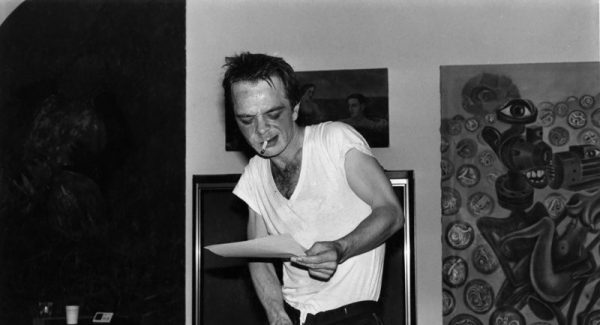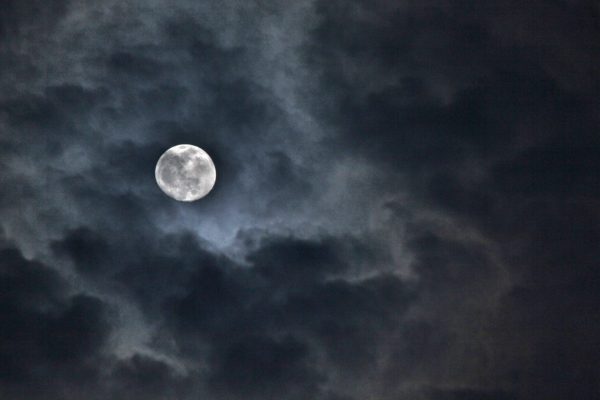I went to see Barbara Loden’s Wanda at a screening at the ICA, not for Nathalie Léger, but for Don DeLillo. I was finishing my PhD on his work and editing a book about him; at that point I was drawn to all things DeLillo, and wanted to see a film that I had read he admired. After reading him on Wanda, I imagined him sitting in the same dark room, watching with me. DeLillo’s appreciation for the film’s qualities meant that I came to it through him — the master of seeing, for whom, as he writes in his story ‘The Starveling’, ‘all human existence is a trick of the light’.
His ‘trick of the light’ takes on new resonances when considered in relation to the unique power of cinematic seeing. As we watch Wanda walk across a quarry in one of the first few scenes of the film, alone in the landscape around her, DeLillo sees the whole film in an instant: ‘the chalky figure in the distance will appear in powerful close-up at the end of the film, face and heart revealed.’ But I would disagree with DeLillo about our proximity to our protagonist: at the close of the film Wanda does not open out to us, but seems more inaccessible than ever. Though film allows for the lives of characters to be rendered in transformative visual metaphors (Wanda dwarfed by her landscape; Wanda engulfed by the frame), the ‘trick’ for me is the inexactness of what these moments depict. No image can ever communicate the totality of a life.
The French writer Nathalie Léger has her own tricks for giving lives new shape and depth, which play out in her informal trilogy about three women artists: the Countess de Castiglione, Barbara Loden and Pippa Bacca. Léger views these women through the intimate lens of her own family and her own writing process, only to zoom out, to place them in their contexts: their time, their history, or their discipline. Her paragraphs shift between these positions, as if viewing her subjects from multiple angles at once. She places no critical distance between herself and these women, but is actively hospitable to them, intermingling her own history with theirs. In each text, Léger’s writing is borne from the women themselves: their lives provide material for new obsessions, and through their work and their working practices, she is led down many paths: she travels to America to visit the coal mines of Pennsylvania, tracking the steps of Wanda; she describes the performance art of Jana Sterbak and Marina Abramović; she meditates on the portraits of Perry Smith or Isabelle Huppert. Each woman is not a simply a singular life, but a library to be read, a house to explore, a plant to grow.
This trilogy has emerged over the last twelve years, and has now been made available in the UK by the London-based publisher Les Fugitives. The first book, Exposition, in which Léger writes about her encounters with the portraits of Italian Countess de Castiglione, was published in France in 2008, and in English translation by Amanda DeMarco in December 2019. The next, and possibly best-known, Suite for Barbara Loden (published in France in 2012, and in English translation by Natasha Lehrer and Cécile Menon in 2015) is a fragmented description of the 1970 film Wanda, the only directorial work ever completed by American actor, writer, and director Barbara Loden. Most recently written and translated is The White Dress, published in France in 2018, and in translation by Natasha Lehrer in March 2020. This focuses on Pippa Bacca, an Italian performance artist who in 2008 travelled across the Balkans into the Middle East in a white wedding dress, on a ‘quest for peace’, as she described it, before she was raped and killed on the journey.
Each book circles around the life of one woman, but Léger’s work goes far beyond biography. Each work is variously laid out not simply as a book but akin to a research project, displaying the way Léger is beguiled by the women she has chosen. Suite started out as an entry in a film encyclopaedia, while Exposition emerged from a project in which Léger was asked to pick an object from the collection of a museum — which she just names C — on which to write. In both cases, Léger acknowledges that she is straying from her task. ‘Please, just write me an entry for the encyclopaedia, not a self-portrait, the editor begged me.’ But she can’t help herself: ‘I wanted to put in everything about Wanda and everything about Barbara – the impossible truth and the indescribable object…’ The head of the museum she works with is more overtly displeased with her work. He quibbles with her choice to write on a portrait of the Countess, reading from a list of far more suitable options, objects of obvious worth, aesthetically beautiful and clearly expensive: ‘The empress’s escritoire… Wardrobe in Chinese lacquer… Graux-Marly torchère lamp…’ At the end of the book, she includes his final rebuke of her work: ‘Ultimately, to be very clear…the project [does] not seem in line with the tastes of the audience of our museum.’
Léger meets derision and suspicion about her project on Bacca much closer to home, in the comments and demands of her mother. Though Léger’s parents appear across the trilogy, her father is speechless, only really appearing as a shifty adulterer moving in and out of the frame of Exposition. Her mother is much more vocal, inquiring into the plot of Wanda, and later telling her daughter, ‘I wonder why you have a taste for sad things.’ But Léger seems to be led not by sadness but by her enthusiasm for difficult stories: she is drawn to Bacca’s journey, for example, because she finds it so perplexing. On 8 March, 2008, the young woman set off across the Balkans in that white wedding dress with, as Léger puts it, ‘the desire to spread goodness, not goodness itself, but the idea of goodness’ to regions that had recently experienced war. As Léger seeks to understand more about this act, which seems to her hopelessly naïve, she has to balance the demands of her ageing mother, whom she is visiting. She senses her mother’s disapproval in her prevarications around the project, and bristles when her mother is visited by friends, to whom she vaguely explains that her daughter does ‘research’. Léger intimates from this inexact description that to her mother, ‘the situation is imperfect… the state of being unsatisfactory.’ But though she might question her daughter’s ability to complete the project, Léger’s mother sees a linkage between herself and Bacca. Having experienced a traumatic and deeply wounding divorce from Léger’s father many years earlier, she understands that ‘violence is the same, great or small; whatever form it takes’ and urges her daughter to write about the case as a means of giving her justice, all these years later.
In spite of the resistance that she meets, Léger continues to write each time. Across the trilogy, it’s clear that we’re reading a writer at the mercy of her subjects. ‘I didn’t know that the subject is precisely what masters you,’ she writes in Exposition. ‘I also didn’t know that the littlest thing could swallow you up.’ In Suite, she continues: ‘I kept being carried away by the subject, and I was appalled, devastated to discover that it had all started, in spite of and even without me, in a state of disorder and imperfection, its incompleteness predictable and its unfinished state programmed.’ But though her research has clearly been extensive, particularly in Suite, between the fragments lie spaces, breaths, as she reconstitutes the aims of her projects, goes down new routes, or returns to old ones. To be ‘mastered’ by her subject is to be obsessed by it, but this does not require her private obsession to be disclosed in all its messy glory. Léger’s voice is not the authoritative one of the expert: as she puts it in Suite, ‘I find myself wavering between wanting to know nothing and wanting to know everything; writing only on the condition that I know nothing, writing on the condition that I omit nothing.’
She contradicts herself constantly, making extraordinary demands of what her writing should be doing. These demands seem to come partly from her readings of the lives and art of the women themselves. As she explains in The White Dress, ‘it was not [Bacca’s] intention that interested me, nor the grandeur of her project, nor her candour, her grace or her foolishness, it was that she wanted, by making this journey, to mend something that was out of proportion, and that she did not make it.’ Léger’s own writing echoes this problem: in the composition of these books in fragments, switching from biography to first-person confessional, literary and art criticism, and family history, she slips and sways, almost losing her footing, then regaining it once more. ‘Let’s try again,’ she writes in Exposition, ‘Start over.’
Her writing seems predicated on its own inability ever to be truly proportional to its subject. This made me wonder: if these books are so troubling for her, why does she insist on her thwarted quests for knowledge? Is this the subject in search of a form, like a crab looking for a shell, or a writer in search of her true subject constantly sidelined by detours? Jacqueline Rose notes in Sexuality in the Field of Vision that psychoanalysis, in visual culture, ‘gives back to repetition its proper meaning and status: not lack of originality or something merely derived (the commonest reproach to the work of art), nor the more recent practice of appropriating artistic and photographic images in order to undermine their previous status; but repetition as insistence, that is, as the constant pressure of something hidden but not forgotten.’ Léger also reroutes repetition, but the repeating excursions of these books feel defiant, as if she is asserting her right to revisit her formula, and indeed, her subjects, as many times as she wants. In The Argonauts, Maggie Nelson insists that there is pleasure to be had in repeating oneself, in action or in thought: one can ‘write the same book over and over again… not because one is stupid or obstinate or incapable of change, but because such revisitations constitute a life.’
But there is also an ethical underscore to Léger’s commitment to the lives of the women she writes on. Lives, Léger’s or someone else’s, cannot fall into easy cut-and-paste forms, particularly when they are troubled or troubling. The Countess de Castiglione was publicly exalted in her beauty, even by those who were reported to have despised her (one observer noted that ‘Mme. de Castiglione was of a consummate beauty, a beauty that did not seem to belong to our time’, while another called her ‘perfection itself, from her birth hair down to her slender feet, delicate and manicured like her hands’). This kind of otherworldly, vaulted public beauty is hard to imagine now, but even more difficult is the squalor in which she died, surrounded by the rotting corpses of her pet dogs. After a life of superlatives, she slips away and is forgotten by the lovers that had shown her off and the public who had venerated her. In Suite Léger’s focus is on both the strange listlessness and melancholy of the main character of Wanda, as well as of Loden’s life itself, tragically cut short by cancer at the age of 40. Loden’s life is contested ground, particularly given her tumultuous relationship and marriage to director Elia Kazan, who later sought to curb and control his wife’s legacy through rewriting her life in his biography, even claiming he had played a much larger role in the writing and direction of Wanda than the credits of the film suggest. Though Léger may claim in The White Dress that ‘I have no vocation for redemption’, it is interesting that each woman she writes on – and other women who feature frequently in her writing, such as Marilyn Monroe – are all subject to control and domination by the narratives of powerful men.
This control is brought to bear most strongly in The White Dress through Léger’s parallel focus on the death of Bacca and the devastating divorce case of her mother. Though she struggles under her mother’s directive to ‘act in my name, you can speak for me, you can…defend me or even avenge me’, in the last few pages of this book, Léger exposes details of a court case in which her father seeks ‘to be the victim, rather than the victimiser, he wanted her to apologise for no longer being loved, he wanted her to be at fault for having been betrayed.’ Her writing grows starker as she describes the aftermath of Bacca’s death, in particular the murderer’s abhorrent use of the camera with which Bacca sought to document her project: ‘He raped her, he killed her, he stripped her naked and finally he stole her gaze.’
Léger’s writing is concerned with the value of its own creation, of its possibility to respond to what she terms elsewhere the ‘annihilation’ of narrative through male violence. This writing is made through doubt about its own capacities, and its own efficacies. But I think there is a benefit to faltering at the possibilities of expression. As Lydia Davis notes in her piece ‘Form as a response to doubt’, ‘Doubt, uneasiness, dissatisfaction with writing or with existing forms may result in the formal integration of these doubts by the creation of new forms, forms that in one way or another exceed or surpass our expectations.’ This trilogy feels more than a feminist recovery of narrative: it is a method through which the lives of women artists are reimagined and remade through the writer herself, a mode of hospitality in which lives coalesce and transform one another.




